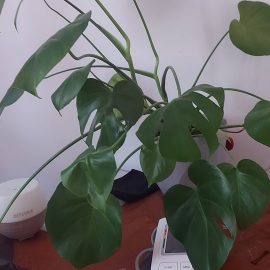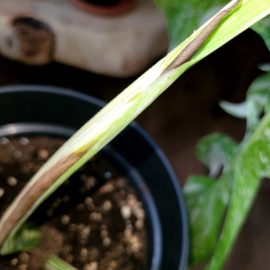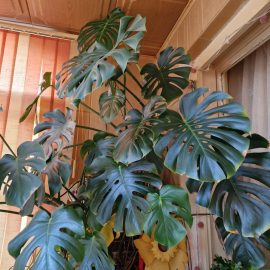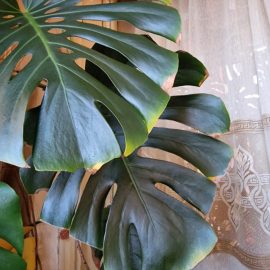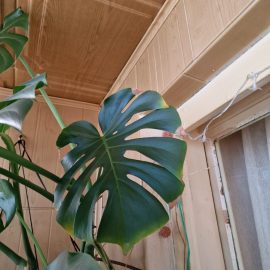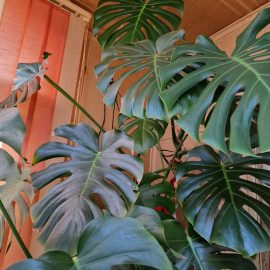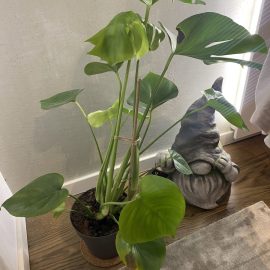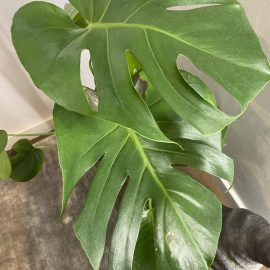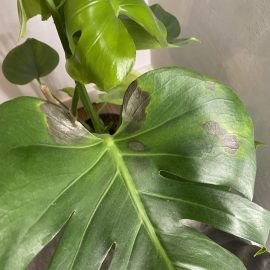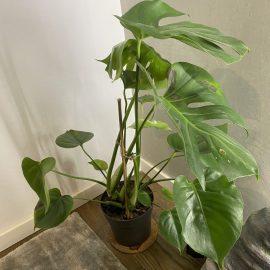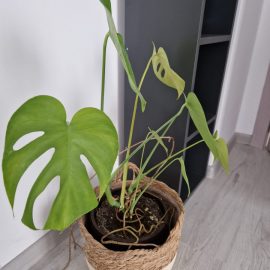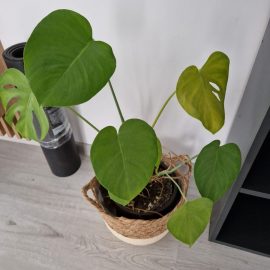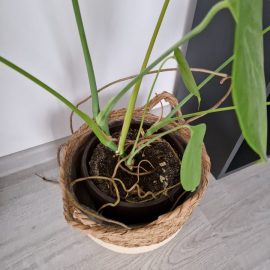Monstera, plant care and growing guide
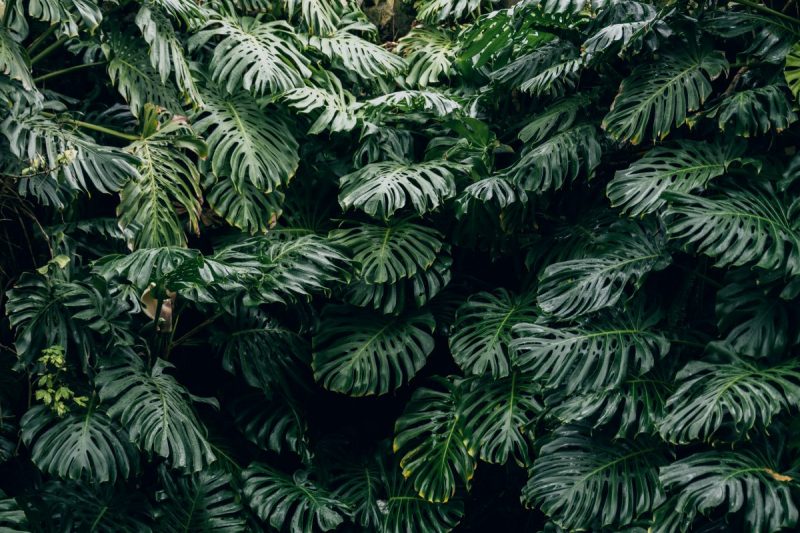
The genus Monstera is part of the Araceae family and includes about 50 species, native to different regions of America, the best known of which is Monstera deliciosa.
Monstera deliciosa is often used as a houseplant, it remains in the vegetative period all year round and is decorated with very large, dark green leaves, which can reach up to 90 cm in length. They are slightly cordiform, cut at the edges, and have perforations on their surface.
It forms an inflorescence in the form of a spadix, the fruits are edible, similar in taste to a pineapple, and have the shape of corn kernels. As a houseplant, it blooms quite rarely.
Species and varieties
It has two varieties:
- Variegata – the leaves have cream-white spots;
- Borsigiana – the leaves are less cut, and the plant grows less.




Environmental conditions
Light. It has a spectacular development if it is positioned in a bright area, it also tolerates less bright spaces, but it will grow less.
Temperature. Being a plant from tropical areas, it prefers higher temperatures, of about 20° C. Temperatures below 10° C can affect the plant growth and development.
Humidity. Monstera is not pretentious to atmospheric humidity, but spraying the leaves once a week can be beneficial to plant development. In the substrate, it is recommended that the humidity be higher in the spring-summer period.
Substrate. The substrate should be fertile and have a very good drainage capacity.
Recommended products
-
You can find products on a different store
Change Store -
You can find products on a different store
Change Store -
You can find products on a different store
Change Store -
You can find products on a different store
Change Store -
You can find products on a different store
Change Store -
You can find products on a different store
Change Store -
You can find products on a different store
Change Store -
You can find products on a different store
Change Store -
You can find products on a different store
Change Store -
You can find products on a different store
Change Store -
You can find products on a different store
Change Store -
You can find products on a different store
Change Store -
You can find products on a different store
Change Store -
You can find products on a different store
Change Store -
You can find products on a different store
Change Store -
You can find products on a different store
Change Store -
You can find products on a different store
Change Store -
You can find products on a different store
Change Store -
You can find products on a different store
Change Store -
You can find products on a different store
Change Store -
You can find products on a different store
Change Store -
You can find products on a different store
Change Store -
You can find products on a different store
Change Store -
You can find products on a different store
Change Store
Watering
Should be done abundantly during the active growing period (spring-summer). However, the substrate must be allowed to dry on the surface between you water the plant again. The substrate must be kept moist, but not too wet. During the cold period, Monstera should be watered moderately, at longer intervals.
Fertilization
It should be fertilized during the active growth period (spring-summer) with a special fertilizer for decorative plants. During the cold period, fertilization has to stop.
Recommended products
-
You can find products on a different store
Change Store -
You can find products on a different store
Change Store -
You can find products on a different store
Change Store -
You can find products on a different store
Change Store -
You can find products on a different store
Change Store -
You can find products on a different store
Change Store -
You can find products on a different store
Change Store -
You can find products on a different store
Change Store -
You can find products on a different store
Change Store -
You can find products on a different store
Change Store -
You can find products on a different store
Change Store -
You can find products on a different store
Change Store -
You can find products on a different store
Change Store -
You can find products on a different store
Change Store -
You can find products on a different store
Change Store -
You can find products on a different store
Change Store -
You can find products on a different store
Change Store -
You can find products on a different store
Change Store -
You can find products on a different store
Change Store -
You can find products on a different store
Change Store -
You can find products on a different store
Change Store -
You can find products on a different store
Change Store -
You can find products on a different store
Change Store -
You can find products on a different store
Change Store
Repotting
It should be done in spring, only when necessary, i.e. when the roots have occupied the entire volume of the pot (once every 4-6 years). Annually, in spring, it is recommended to replace the soil from the surface of the pot with a fresh one.
Propagation
It is propagated through top cuttings and stem fragments. Rooting should be done in a solid substrate, such as perlite or fibrous peat. Another method of propagation is through air layering.
Recommended products
-
You can find products on a different store
Change Store -
You can find products on a different store
Change Store -
You can find products on a different store
Change Store -
You can find products on a different store
Change Store -
You can find products on a different store
Change Store -
You can find products on a different store
Change Store -
You can find products on a different store
Change Store -
You can find products on a different store
Change Store -
You can find products on a different store
Change Store -
You can find products on a different store
Change Store -
You can find products on a different store
Change Store -
You can find products on a different store
Change Store -
You can find products on a different store
Change Store -
You can find products on a different store
Change Store -
You can find products on a different store
Change Store -
You can find products on a different store
Change Store -
You can find products on a different store
Change Store -
You can find products on a different store
Change Store -
You can find products on a different store
Change Store -
You can find products on a different store
Change Store -
You can find products on a different store
Change Store -
You can find products on a different store
Change Store -
You can find products on a different store
Change Store -
You can find products on a different store
Change Store
Recommended products
-
You can find products on a different store
Change Store -
You can find products on a different store
Change Store -
You can find products on a different store
Change Store -
You can find products on a different store
Change Store -
You can find products on a different store
Change Store -
You can find products on a different store
Change Store -
You can find products on a different store
Change Store -
You can find products on a different store
Change Store -
You can find products on a different store
Change Store -
You can find products on a different store
Change Store -
You can find products on a different store
Change Store -
You can find products on a different store
Change Store -
You can find products on a different store
Change Store -
You can find products on a different store
Change Store -
You can find products on a different store
Change Store -
You can find products on a different store
Change Store -
You can find products on a different store
Change Store -
You can find products on a different store
Change Store -
You can find products on a different store
Change Store -
You can find products on a different store
Change Store -
You can find products on a different store
Change Store -
You can find products on a different store
Change Store -
You can find products on a different store
Change Store -
You can find products on a different store
Change Store
Diseases and pests
The most common pests are mealybugs and mites. The occurrence of diseases can be determined by inadequate growth conditions.
Recommended products
-
You can find products on a different store
Change Store -
You can find products on a different store
Change Store -
You can find products on a different store
Change Store -
You can find products on a different store
Change Store -
You can find products on a different store
Change Store -
You can find products on a different store
Change Store -
You can find products on a different store
Change Store -
You can find products on a different store
Change Store -
You can find products on a different store
Change Store -
You can find products on a different store
Change Store -
You can find products on a different store
Change Store -
You can find products on a different store
Change Store -
You can find products on a different store
Change Store -
You can find products on a different store
Change Store -
You can find products on a different store
Change Store -
You can find products on a different store
Change Store -
You can find products on a different store
Change Store -
You can find products on a different store
Change Store -
You can find products on a different store
Change Store -
You can find products on a different store
Change Store -
You can find products on a different store
Change Store -
You can find products on a different store
Change Store -
You can find products on a different store
Change Store -
You can find products on a different store
Change Store
In addition:
- excessive moisture in the substrate can lead to root rot.
- it is recommended to spray the leaves once a week or wipe them with a damp cloth.
Caution! The leaves are highly toxic.














































































































































































































































































































































































































































